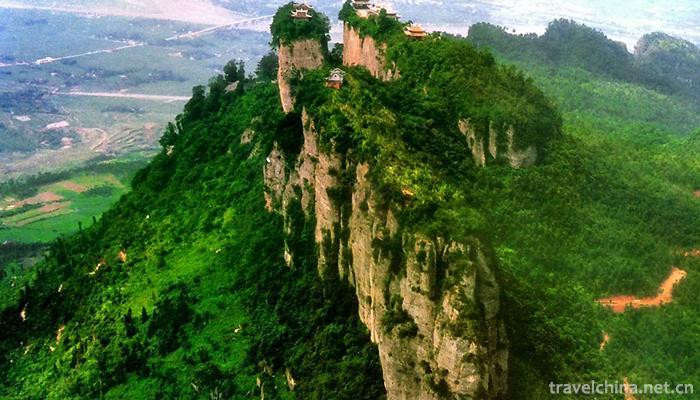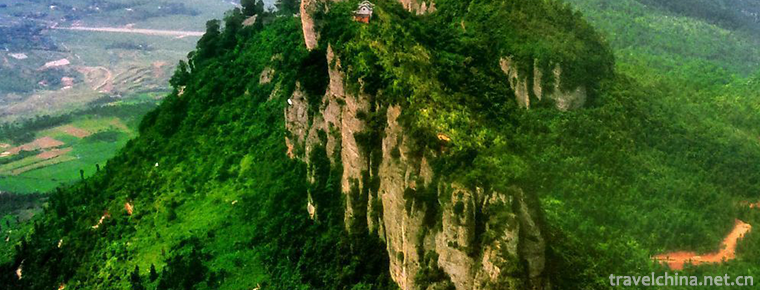Jiangyou Dou Meishan Scenic Area
Jiangyou Dou Meishan Scenic Area
Dou Meishan Scenic Spot is an important part of Jianmen Shudao National Scenic Spot. It is 25 kilometers north of Jiangyou City and 170 kilometers away from Chengdu. It is a famous Danxia Landscape Scenic Area in Sichuan Province. Dou Meishan is named after Dou Ziming, the master book of Zhangming County in Tang Dynasty, who once practiced Taoism here, feathering and soaring. It attracts tourists both at home and abroad with its peculiar peaks, thrilling cables, ancient temples and various tourism projects. When Li Bai, a poetry fairy, visited this place, he left behind the eternal cliche of "Woodcutter and Tiller, Enter and Enter the Painting Screen".
Yunyan Temple, an ancient temple in the mountains, was built during the reign of Tang and Qianfu (874-879 A.D.). The temple is facing the negative mountain of rock and has great momentum. It has experienced the alternation of damage and repair in Tang, Song, Yuan, Ming and Qing Dynasties, and the struggle between Buddhism and Taoism. Finally, it has formed the pattern of "East Zen Forest and West Dao View". The integration of Buddhism and Taoism culture and ancient architecture is a very special group of ancient temples in China. Feitianzang (also known as Star Car) was built in the eighth year of Chunxi in the Southern Song Dynasty (AD 1180). Its workmanship was exquisite and complicated, and the flying dragon coiled around it. Its woodcarving and Taoist portraits were beautiful and lifelike. It is the essence of the cultural connotation of Dou Mei Mountain. It was published as a national key cultural relic in the eighth year. The three solitary stone peaks behind the temple are connected by cables. The cable bridge was built in the Tang Dynasty. The existing cable bridge was built in the five years of Yongzheng in the Qing Dynasty. It is a great wonder in the history of Chinese bridges. The cable bridge with a height of 50 meters is only "Feixian Fei Fei Fei Fei Fei Fei Fei Fei Fei Fei Fei". The performers walk in the sea of clouds and fog. It is so dangerous that it can be called the unique side of China's scenery.


-
1.Huizhou stinky tofu
The common name of stinky tofu in Huizhou is "Big Dumb and stinky", which is a characteristic traditional snack in Huizhou, Anhui Province.
Time 2018-11-27 -
2.Tourist Hall of Shanghai Global Financial Center
Shanghai Global Financial Center is located at 100 Century Avenue, Pudong New Area, Shanghai. It is a skyscraper located in Lujiazui Financial and Trade Zone. It faces the hinterland of Pudong New Are
Time 2018-12-19 -
3.Chen Yuns former residence and Qingpu Revolutionary History Memorial Hall
Chen Yun's former residence and the Qingpu Revolutionary History Memorial Hall are the only Memorial Hall in the country that systematically demonstrates Chen Yun's life achievements approved by the C
Time 2019-01-05 -
4.Daqing Oilfield History Exhibition Hall
Daqing Oilfield History Exhibition Hall is the first original Memorial Hall in China with the theme of petroleum industry, and it is a cultural relic protection unit in Heilongjiang Province.
Time 2019-01-07 -
5.Linzhou Taihang Grand Canyon Scenic Area
Taihang Grand Canyon Scenic Area is located in Linzhou City, northwest of Henan Province, on the eastern foot of the southern Taihang Mountains. It is 100 miles long in the north and south
Time 2019-01-30 -
6.High cavity
Gaoqiang is one of the four major tunes in Chinese opera. Gaoqiang was originally called "Yiyang Cavity" or "Yiqiang Cavity", because it originated in Yiyang, Jiangxi Province.
Time 2019-04-30 -
7.Glass Firing Techniques
Glass firing technology, Beijing Mentougou District, Shanxi Province, local traditional handicraft, one of the national intangible cultural heritage.
Time 2019-05-14 -
8.Ningxia Xiaoqu
Ningxia Xiaoqu, a national intangible cultural heritage project, is a traditional rap art form with strong local characteristics.
Time 2019-06-08 -
9.Sheng Guanyue
The term "Sheng wind music" is not only a popular name in Chinese folk, but also a scientific name in the current academic circles. It refers to the orchestral performance form consisting of
Time 2019-06-14 -
10.Guan Zhong
Guan Zhong (about 723 BC - 645 BC) Ji surname Guan Shi, name Yi Wu, character Zhong, posthumous title, Yingshang (now Yingshang County, Anhui) A famous economist, philosopher, statesman and strategist
Time 2019-09-07 -
11.Population of Deyang
By the end of 2018, the total number of households in Deyang was 1 million 575 thousand, and the total registered residence population was 3 million 870 thousand. Among them, there were 1 million 242 thousand urban residents and 2 million 629 thousand rural population
Time 2020-12-14 -
12.Hydrology in Yibin
The water system in Yibin belongs to the external water system, with the Yangtze River as the main vein, with many rivers, high density and abundant water. Jinsha River and Minjiang River join to form the Yangtze River, which runs through the nor
Time 2020-12-18